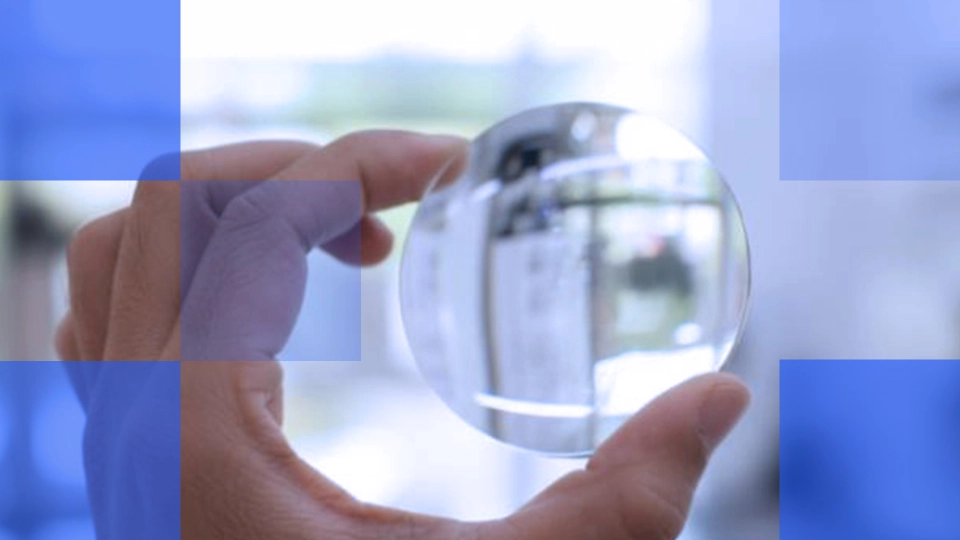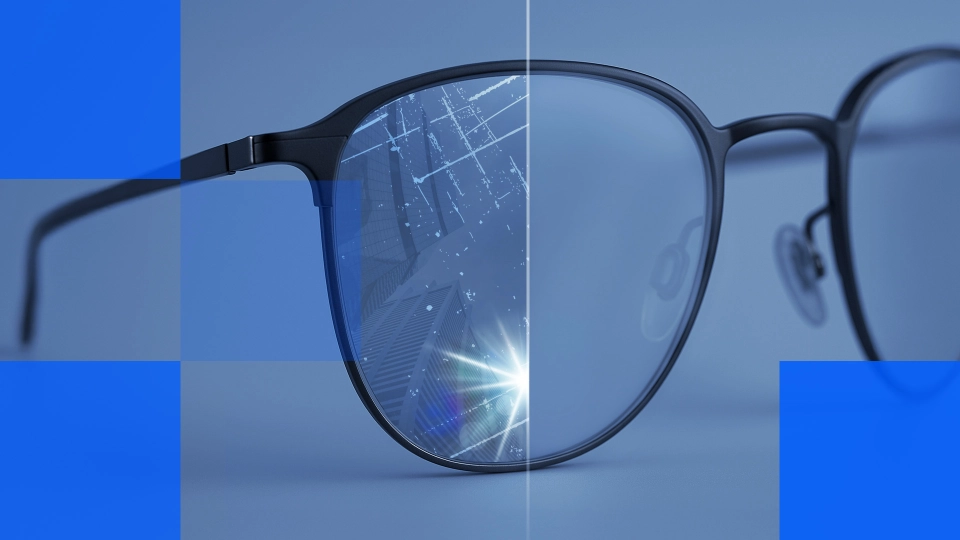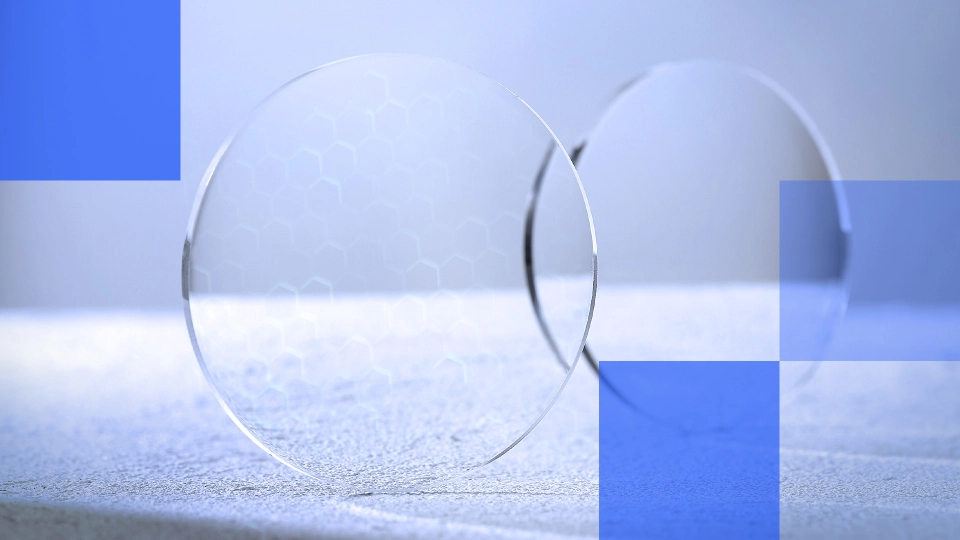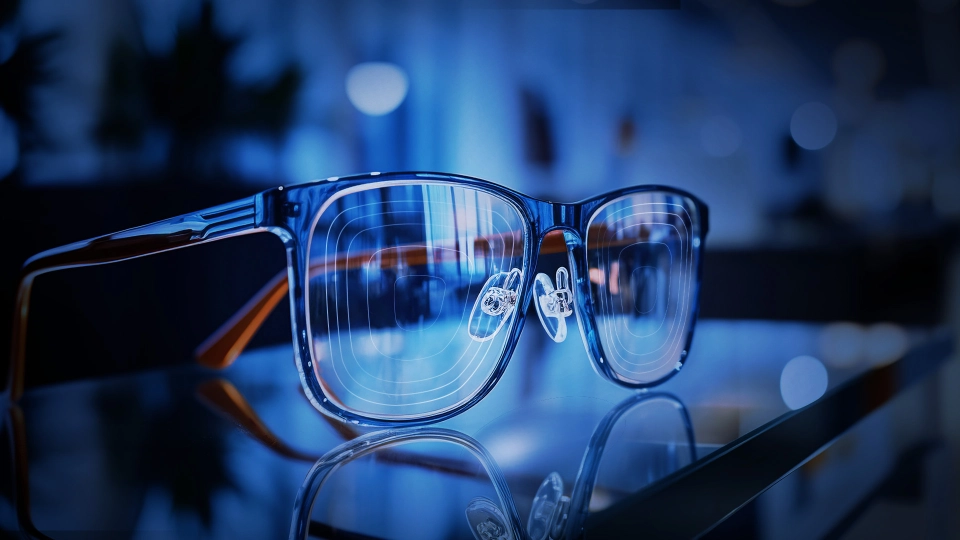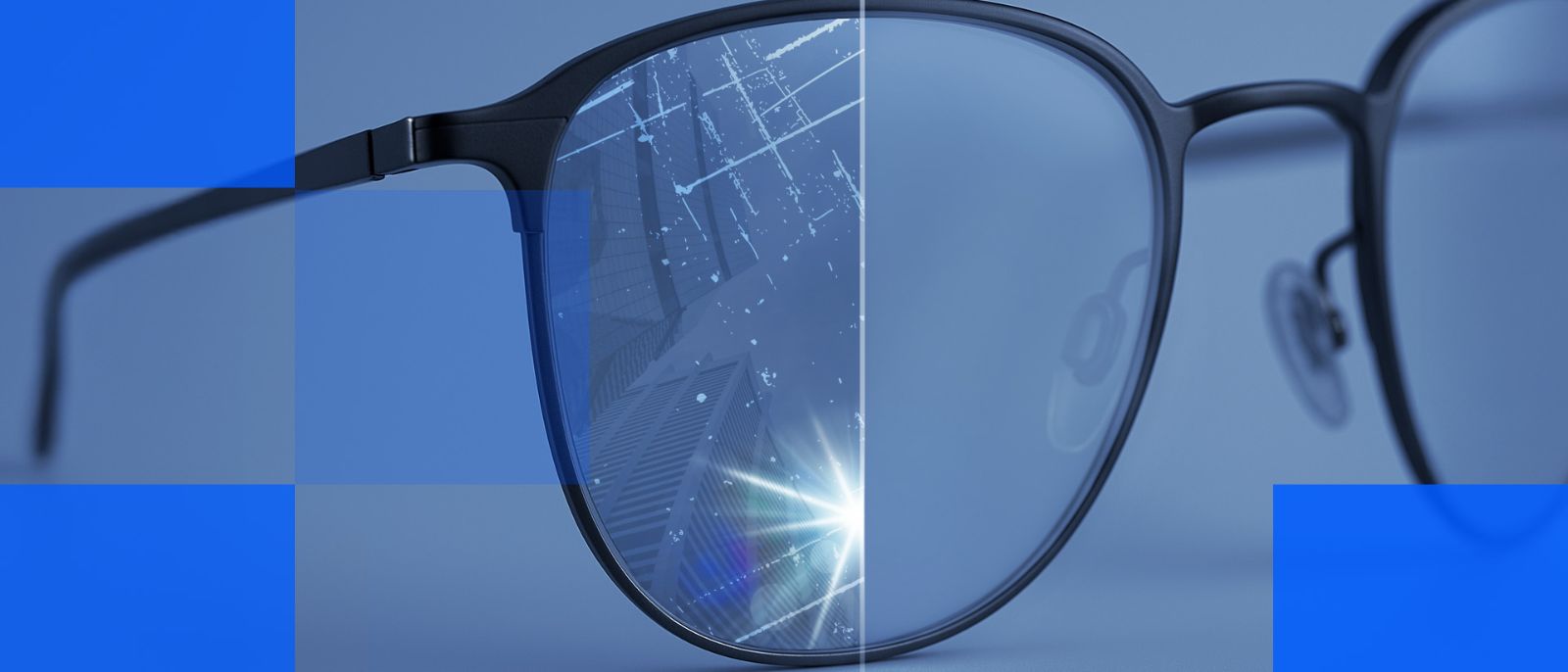
5 Types of Lens Coatings: What Labs & ECPs Need to Know
- 1. Anti-reflective (AR) coatings
- 2. Scratch-resistant protective coatings
- 3. UV blocking coatings
- 4. Blue light filters
- 5. Mirror coatings
- Common coating problems and solutions
- 1. Adhesion failures
- 2. Uneven curing or coating
- 3. Optical quality issues
- Best practices for labs applying coatings
- Maximize coating performance with IOT

5 Types of Lens Coatings: What Labs & ECPs Need to Know
Lens coatings are not often the first topic that comes to mind when someone mentions lens design, yet they are just as important as any other aspect of the eyeglasses. These advanced thin-film technologies improve patient satisfaction, optimize visual performance, and extend lens durability. Yet, not all coatings are created equal.
Labs and eye care professionals (ECPs) must balance material compatibility, coating process, wear resistance, and patient lifestyle when recommending or applying coatings. Because even when manufacturers apply coatings with molecular-level precision, wearers only notice a benefit when it solves their optical problems. Understanding coating fundamentals and application best practices will help ECPs prescribe better solutions and labs to avoid coating failures.
Comprehension begins with a better understanding of the differences between various coatings. Essential lens coatings on the market today are as follows:

1. Anti-reflective (AR) coatings
Anti-reflective (AR) coatings reduce surface reflections on the front and back of lenses. This boosts light transmission, improves night vision, reduces glare from screens or headlights, and enhances cosmetic appearance by making the lenses more transparent.
High-performance professionals, such as surgeons and pilots, benefit from premium AR systems that offer superior clarity and minimal reflections. If a patient works in an environment with airborne contaminants and frequently touches their lenses, they will benefit from the additional oleophobic treatment.
AR coating veriations
- Standard AR coatings: Stock standard coatings use alternating layers of high and low refractive index materials. The standard AR provides reduced glare at a lower cost when compared to premium coatings.
- Hydrophobic/oleophobic AR: Added to the Basic AR coating, a topcoat that repels water and resists oil and fingerprints to reduce smudging. The performance difference is noticeable in challenging environments or with patients who have higher visual demands.
- Ion-assisted deposition AR coatings: This premium AR coating is formed through ion bombardment during deposition, creating denser, more durable films. This coating type is more expensive than standard AR, but offers greater longevity and improved optical performance.
2. Scratch-resistant protective coatings
Hard coatings provide a protective layer that improves surface durability during everyday use and cleaning. This makes a lens more resistant to scratches, particularly when working with softer, high-index materials like 1.60, 1.67, or 1.74, which are more prone to surface damage than CR-39. Polycarbonate is also especially delicate and benefits significantly from a hard coating. While most lenses today include this layer, some low-cost CR-39 lenses are still occasionally sold without one, putting them at greater risk of cosmetic defects and reduced clarity over time.
It’s important to always match the scratch-resistant coating to the lens substrate. For example, coatings formulated for Trivex won’t perform the same on polycarbonate. Additionally, a coat needs to polymerize for the exact correct time and temperature, as under-cured hard coats create weak spots that evolve into coating failures months later. Conversely, over-curing can create surface stress that leads to cracking and also produces a yellowish effect. The index of the lacquer needs to match the lens index to avoid the Newton rings effect on the lenses.
Patients with an active lifestyle benefit from protective coatings that can withstand more stress, activity, and cleaning.
Key points
- Thermal cure (Dip coating) vs. UV cure (Spin Coating): Thermal curing produces harder, more durable layers. UV-cured coatings offer faster processing but may be slightly less resistant to wear.
- Dip vs. spin coating: Dip coating tends to yield more uniform results but requires cleanroom conditions. Most high volume labs use it because the dip coating machine can process and produce more lenses. However, for just one order, spin coating has a shorter processing time.
3. UV blocking coatings
UV light-blocking coatings provide additional protection on lenses where substrate absorption may be incomplete, and they allow for UV protection in materials that don't inherently block UV radiation. This helps prevent cumulative UV damage to the eye, like cataracts, pterygium, and retinal issues.
Often, designs combine UV coatings with photochromic lenses. These lenses provide a fast fade-to-black effect when exposed to UV light and quickly clear when UV light is removed.
Key points
- Interaction considerations with other coatings: The interaction between UV coatings and other coating layers can sometimes cause issues. Some UV absorbers can interfere with AR coating performance or cause premature degradation of other coating components under intense UV exposure.
- Application: Combine UV-blocking coatings with AR to avoid back-surface UV reflection.
4. Blue light filters
Blue light filtering coatings are in higher demand as more people spend hours each day on digital devices. These filters have evolved from simple yellow tints to selective filters that target short-wavelength blue light (typically in the 400–455 nm range), which is associated with digital eye strain and potential circadian disruption. LED lights emit the higher-energy blue light at 450 nm.
There are different types of blue-blocking coatings, with some blocking a narrow slice of blue light and others maintaining a broader blocked spectrum:
Blue light coating variations
- Absorptive blue light filters: These filters absorb specific wavelengths of blue light by incorporating chromophores directly into the coating. Absorptive blue light lenses often have a yellow or amber tint. This coating type provides consistent filtering regardless of viewing angle, but can introduce slight color shifts to the wearer.
- Reflective blue light filters: These filters have a special coating on the lens surface that reflects (rather than absorbs) specific wavelengths of blue light away from your eyes. This approach has minimal color distortion to the wearer, but the lenses have slight blue reflections that are cosmetically noticeable. The filtering effectiveness also varies with viewing angle. These filters block a smaller percentage of light compared to absorptive filters.
5. Mirror coatings
Mirror coatings reflect visible light and reduce glare in high-brightness environments, such as bright sunlight, water, and snow. The most significant difference between AR coatings is their aesthetic appearance. Mirror coatings have a highly reflective surface and are available in a variety of colors, adding a stylish and personalized touch. Lenses with a mirror coating are popular in sportswear due to their aesthetic appeal.
Key points
- Base preparation for coating: Mirror coatings are typically applied over a tinted or polarized base lens and must be paired with durable scratch-resistant and anti-reflective stacks underneath to protect against abrasion.
- Colors change purpose: Different colors of a mirror coat work better in different conditions. For example, a blue mirror coat is helpful in conditions with a lot of blue light, such as on the ocean or snow. A red mirror coat is more useful on very sunny days.
Common coating problems and solutions
Coating failures rarely occur randomly. They typically result from process deviations or environmental factors. Understanding common coating problems helps labs implement preventive measures and improve yields.

1. Adhesion failures
Adhesion failures manifest as coating peeling or flaking and typically result from improper surface preparation or contamination. Even minor residue on the lens can disrupt coating bonds. Common causes include insufficient cleaning, poor surface etching, both in HC (hard coat) and/or AR (anti-reflective), residual polishing compounds, or inconsistencies in plasma treatment.
Solution: Labs should implement rigorous cleaning protocols and regular maintenance of the plasma system, AR machines, and HC machines.
2. Uneven curing or coating
Variability in spin speed, cure temperature, or dipping lift-out speed can result in patchy coatings. An uneven coating layer leaves weak spots if unprotected or areas more likely to crack if the coating is too thick. This results in less durability and premature wear.
Solution: Check regularly solid contents of the lacquers, lift-out speed, viscosity, etc. Utilize precision-calibrated machinery and conduct regular quality control tests (e.g., Bayer tests) to ensure optimal performance.
3. Optical quality issues
Haze, color variation, or reflection anomalies often stem from deposition parameter variations. Chamber contamination, target degradation, or gas flow inconsistencies can create these problems.
Solution: Regular maintenance schedules and process monitoring help prevent degradation in optical quality.
Best practices for labs applying coatings
Following strict application protocols and maintaining exacting machine standards is the foundation of high-yield, defect-free coating processes. Labs that consistently achieve premium results typically excel in these areas:
1. Environment & cleanroom control
- Maintain ISO-certified cleanroom standards with controlled temperature and humidity to prevent static buildup and dust attraction.
- Use positive air pressure systems to keep contaminants out, with HEPA-filtered airflow across critical coating zones.
- Enforce full gowning procedures (hairnets, gloves, shoe covers, anti-static clothing, etc) to minimize particle introduction.
- Regularly audit airflow patterns, particle counts, and cleanroom integrity.
2. Lens preparation & handling
- Implement multi-stage ultrasonic cleaning with monitored detergent concentration and water quality (deionized water at ≤ 1 µS/cm conductivity).
- Ensure polishing compound removal through optimized surfactant use and rinse cycles.
- Verify complete drying before hard coat or AR application to avoid trapped moisture.
- Use lint-free gloves and tools to handle lenses after final cleaning to prevent recontamination.
3. Coating material management
- Store hard coat lacquers and AR materials per manufacturer specifications (temperature, light exposure, shelf life).
- Mix or replenish coating baths only with measured, filtered additions; monitor viscosity, cooling temperature, and solid content.
- Match lacquer index to the lens substrate index to prevent Newton rings.
- Replace bath solutions on a preventative schedule rather than reactively to defects.
4. Process control & calibration
- Calibrate spin speeds, lift-out rates, cure times, and cure temperatures according to the substrate and coating type.
- In dip coating, control withdrawal (lift-out) speed to get the desired lacquer thickness and maintain uniform thickness.
- For thermal curing, log oven temperature profiles and verify with calibrated probes; avoid temperature overshoot that can induce yellowing or surface stress.
- Maintain vacuum chamber parameters (pressure, gas flow, cleaning conditions) for AR and mirror coatings, with real-time monitoring where possible.
5. Layer compatibility checks
- Confirm all coating layers (hard coat, AR stack, topcoat, mirror) are designed to work together chemically and mechanically.
- Test adhesion between each layer type in small batches before scaling to full production.
6. Preventive maintenance & quality assurance
- Schedule regular preventive maintenance for coating lines, including pump seals, filters, bath circulation systems, and UV/thermal curing equipment.
- Maintain detailed process logs, including lot numbers for coatings and substrates, machine settings, and operator notes.
- Perform Bayer abrasion tests, adhesion tests, haze measurements, and spectral reflectance checks as part of in-process quality control — not just at final inspection.
- Track defect trends to identify root causes (environmental, mechanical, or human factors) and implement corrective actions.
By implementing these controls, labs can dramatically reduce rework, extend coating life, and consistently meet premium optical performance standards.
Maximize coating performance with IOT
Superior coating performance isn’t just about equipment. It starts with smart lens design, material compatibility, and consistent process control. That’s why IOT supports labs with technologies that make coating easier, more reliable, and more customizable.
Whether you’re using Neochromes photochromic lenses or Endless Steady progressive designs, IOT’s materials provide excellent adhesion for modern coating stacks. Our lens designs and substrates are developed to support high-yield, high-performance coating applications. IOT partners benefit from:
-
Tailored coating recipes for AR stacks, blue light filters, and mirror coatings
-
Validated compatibility with hard coat, AR, and photochromic treatments for highest performance
- Access to process control support and and standardized quality control tests in the market (e.g. Bayer abrasion testing, QUV aging, adhesion, haze and spectral reflectance checks)
Whether you’re launching a new mirror series or improving yield on AR stacks, our coating-ready lens platform and technical expertise give our partners a competitive edge in performance and reliability.
Contact us today to find out how we can optimize your coating process together.

